Deep in the frozen bowels of Game of Thrones' most iconic castle, all my winters are coming at once. In the gloom looms a statue of poor Lord Eddard Stark – better known to viewers of the HBO blockbuster as Ned who tragically lost his head.
He wears a slightly startled expression, as if someone especially cunning has just outsmarted him and is about to convey the Warden of the North to the nearest convenient chopping block. Beside Ned is the likeness of his tragic sister, Lyanna. Her eyes are wide and sad, her hands clasped.
A few steps from this melancholic tableaux, I am trying not to combust from sheer giddy joy.
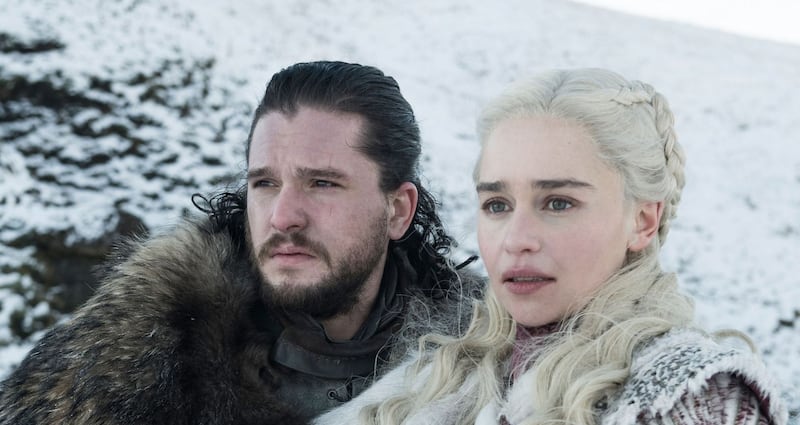
For a fan the chance to step into the vaults beneath Winterfell, fortress home of House Stark, is the ultimate pinch-yourself experience
For a Game of Thrones fan the opportunity to step into the hallowed vaults beneath Winterfell, fortress home of House Stark, is the ultimate pinch-yourself experience. This grim catacomb has a starring role in the teaser trailer for the imminent eighth and final season of the swords-and-sorcery romp to rule them all.
As the Game of Throne theme lulls menacingly, the Winterfell triple threat of Jon Snow and Sansa and Arya Stark stride down the corridor, passing these very effigies of Lyanna and Ned, only to be finally confronted by frowning images of themselves. It’s a thrilling, chilling reminder that Game of Thrones is hurtling towards its endgame.
I'm not actually in Winterfell, of course. I'm in the Titanic Exhibition Centre in Belfast for an exclusive preview of its blockbuster new presentation. Belfast's Titanic Quarter is the perfect location for Game of Thrones: The Touring Exhibition. Across the road from the hulking complex stands Titanic Studios, where much of Game of Thrones was shot, beginning in 2010. Just a 40-minute drive away is the "real" Winterfell, Castle Ward, in Downpatrick.
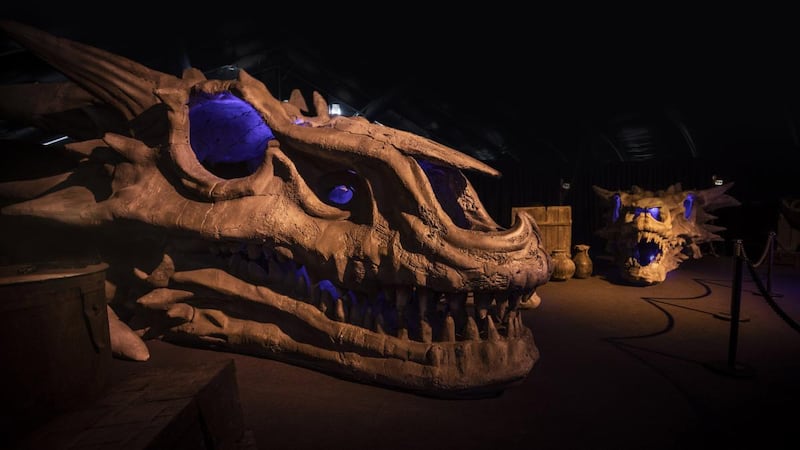
Game of Thrones: The Touring Exhibition, run in conjunction HBO, is a coup for the Titanic Quarter. Featuring costumes, weaponry and even gargantuan dragon skulls from the show, it opens tomorrow, three days before Game of Thrones returns for its final run of episodes. And though the exhibition has already been to Germany, France and Spain, the Winterfell statues are a new addition. Until a few months ago they were in active service on the Game of Thrones set.
'They've tried to re-create the smell of rotten meat,' says my guide. 'Rotten meat' isn't quite what I'm getting – more scented candle gone wrong
In the darkness and the silence of the curtained-off area, with Ned’s face glimmering from the shadows, you can almost reach out and touch the world of George RR Martin’s Song of Ice and Fire, the series of novels from which Game of Thrones is adapted. Later, I am able to smell it, too, as I pass through the gate at Castle Black, and out into the frozen North.
“They’ve tried to re-create the smell of rotten meat,” says my guide, Sarah Hamilton-Cardy of Titanic Belfast. “North of the Wall, life is less civilised. The smells are meant to communicate that.”
“Rotten meat” isn’t quite what I’m getting – more scented candle gone wrong. Still, it’s wonderfully evocative. Of course the scary ambience might have something to do with the two White Walkers – the Westeros equivalent of zombies – pulling faces in the murk.
The Walkers share the space with a fur outfit belonging to the Wildling Ygritte, alongside her bow and dagger. Ygritte, as fans will tell you with a sniffle, was Jon Snow’s one true love. At least until they had a falling out during which she shot him three times with the very bow I am gazing at. Yes, it was awkward.
Every hair on my neck is by now standing up. At the risk of coming across as a slavering fanboy – and I am slavering a bit – Game of Thrones: The Touring Exhibition is every Westeros diehard’s ultimate fantasy made real. All of the costumes and props were used in the series, and look as if they’ve been brought here straight from the Seven Kingdoms.
The detail is stunning. The tunic of Tywin Lannister, Westeros’s Machiavellian genius, features clasps fashioned in the likeness of the Lannister lion. And it bears the Hand of the King emblem that Tywin took from his son Tyrion after the Battle of the Blackwater in season two. (Cheeky Tyrion later got his own back, shooting his dad on the privy.)
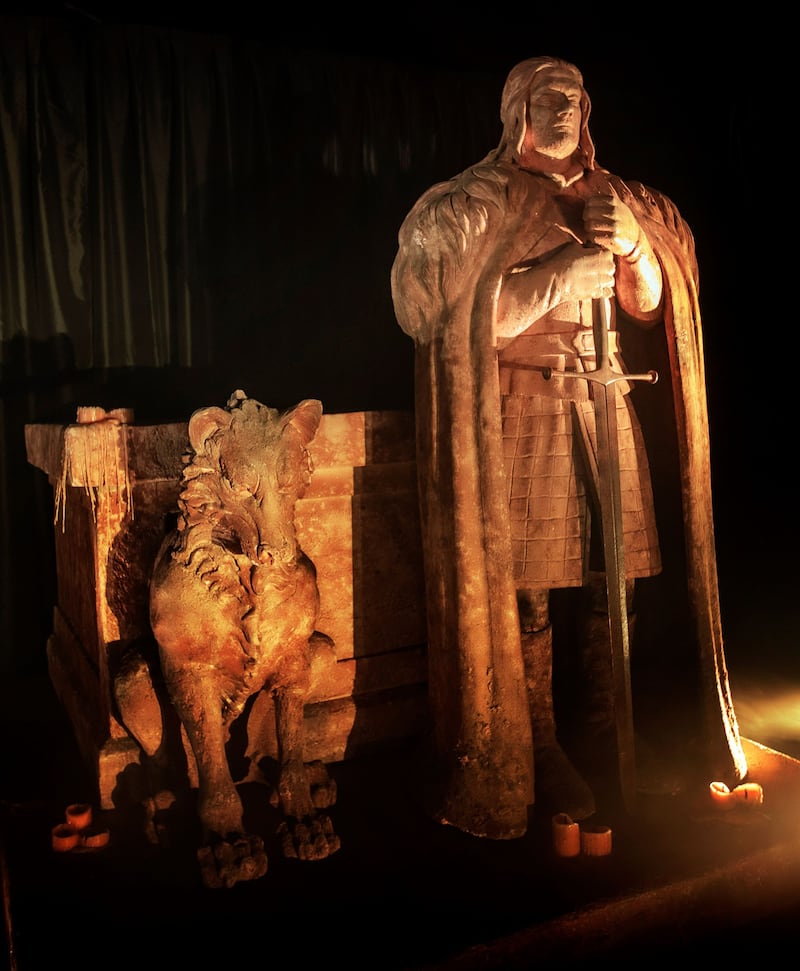
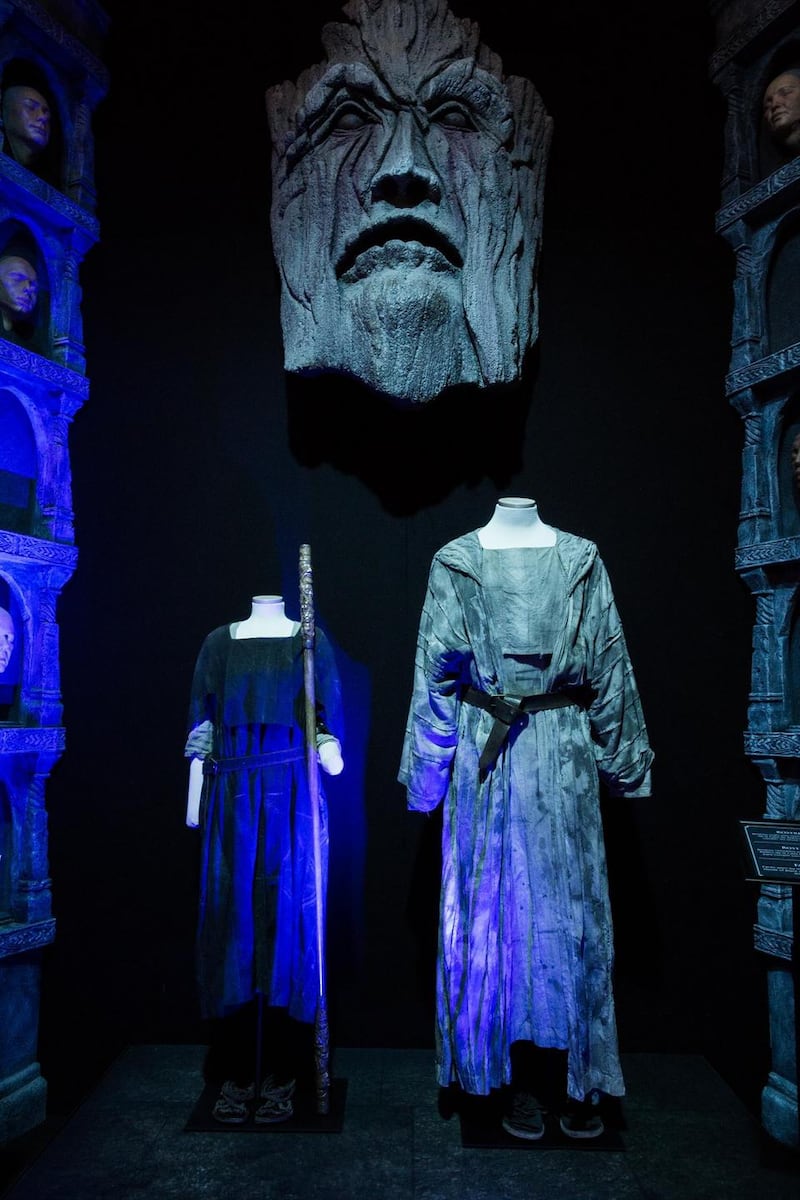
In an adjoining room Arya Stark’s tiny urchin’s blouse stands beside the hulking armour of Sandor Clegane, aka the Hound. A mock-up of the House of Black and White, where Arya trained to be a face-changing assassin, is dominated by a huge stone head. I stoop over a small tablet that takes my photograph. A moment later my image appears on the wall of victims of the Faceless Men. Risking a scene, I wave excitedly at myself.
Eight years ago, in the subzero studio across the road, I witnessed the Game of Thrones producer Bryan Cogman overseeing a season-two scene in which Arya serves as Tywin's cupbearer. Later, still in his imperious outfit, Charles Dance, the actor who plays Tywin, expressed the view that shooting Game of Thrones in Ireland made the show particularly special, because of the landscape's "mystical" qualities.
What was clear then and now is the incredible artistry that has gone into Game of Thrones. The series is about more than a twisting, weaving plot and gratuitous nudity – although both are part of the appeal. It is also a testament to George RR Martin’s intricate world-building and the care and attention with which the drama’s showrunners, David Benioff and DB Weiss, brought his vision to the screen.
Up close the craftsmanship is breathtaking, a testament to the obsessive love the costume designer Michele Clapton put into her work
Up close the craftsmanship is breathtaking, a testament to the obsessive love the costume designer Michele Clapton put into her work. Stopping by Margaery Tyrell and Joffrey Baratheon’s wedding outfits, for example, Sarah Hamilton-Cardy points out that the stitching in Margaery’s dress, which took 12 weeks to make, resembles a spiral of thorns.
That’s a reference to the rose sigil, or emblem of her noble house. In a nearby glass display is the golden hand belonging to Jaime Lannister – he lost his original back in season three – and the stone eyes placed over Joffrey and his grandfather Tywin when each met a sticky end in series four.
Next is a minishrine to the One True King of Westeros, Stannis Baratheon. (You know I’m right.) His breastplate is emblazoned with the Baratheon stag. Alongside is the red shawl of his trusted adviser/resident religious lunatic, Melisandre. Of the daughter Stannis burned at the stake in season five, to gain the favour of the Lord of the Light, there is no sign. Sigh. You can’t have everything.
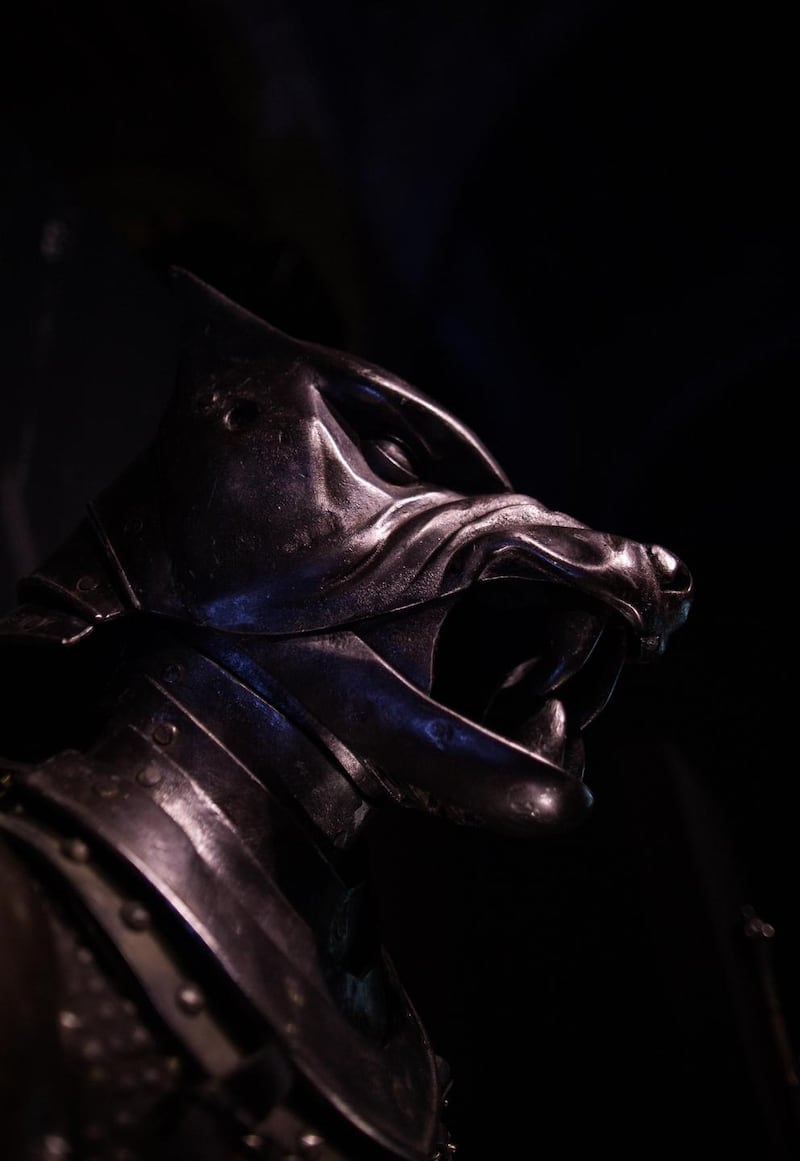
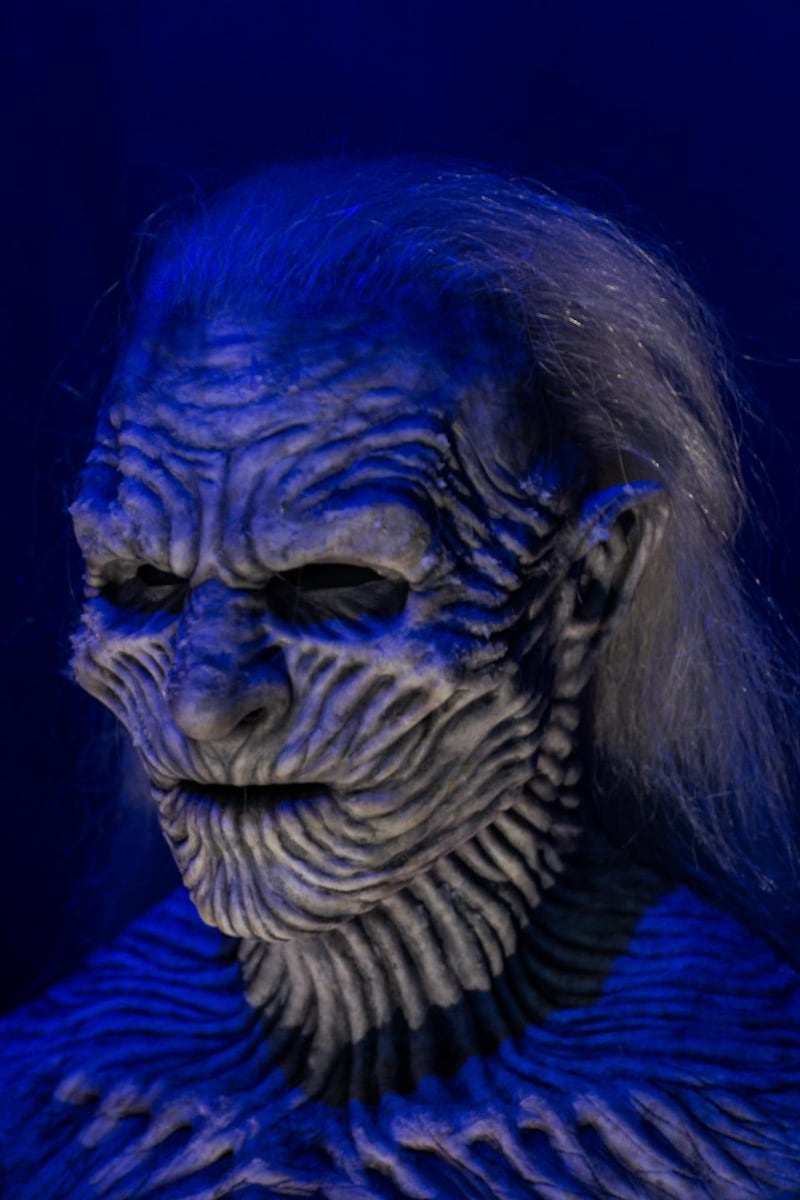
The scale of some of the pieces is amazing. The Iron Throne of the Seven Kingdoms bristles on the way to the sprawling gift shop. (Warning: your credit card may suffer the same fate as the Lannister army when Daenerys swooped in with Drogon the dragon in season seven.) A mock-up of the dungeons of the Red Keep in King’s Landing features enormous dragon skulls – including a re-creation of that of Balerion, the Black Dread, said to be the largest fire-breather in the history of Westeros. It’s huge.
Game of Thrones doesn’t really do heroes. As soon as anyone puts their head above the parapet and behaves selflessly, the show is liable to lop it off (literally in the case of Ned Stark and his son Robb). But the two protagonists in whom viewers are most invested are probably Jon Snow, Bastard of Winterfell, and Daenerys Targaryen, Mother of Dragons.
Both have pride of place in the exhibition. Several Daenerys frocks catch the eye. First up is one of her midseries ensembles. It’s a ravishing blue gown from her interminable mooch around Slaver’s Bay, in Essos. (Imagine Mayo’s quest for an All-Ireland, only even lengthier and more futile.) Behind her is the smock of her handmaid/adviser/best friend forever, Missandei. And, to either side, the metal armour and shields of the Unsullied, Daenerys’s supremely loyal private army.
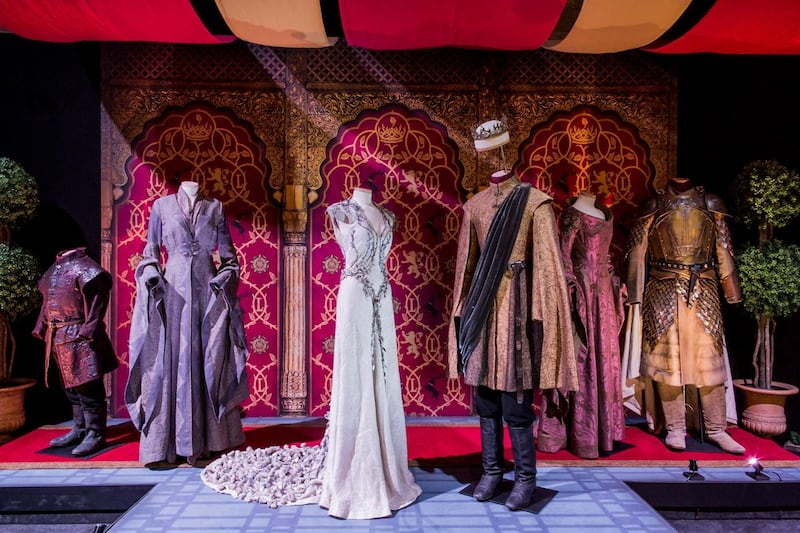
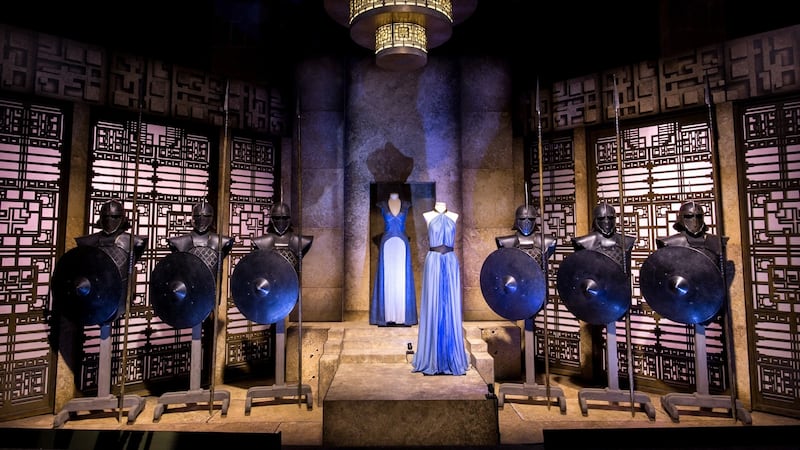
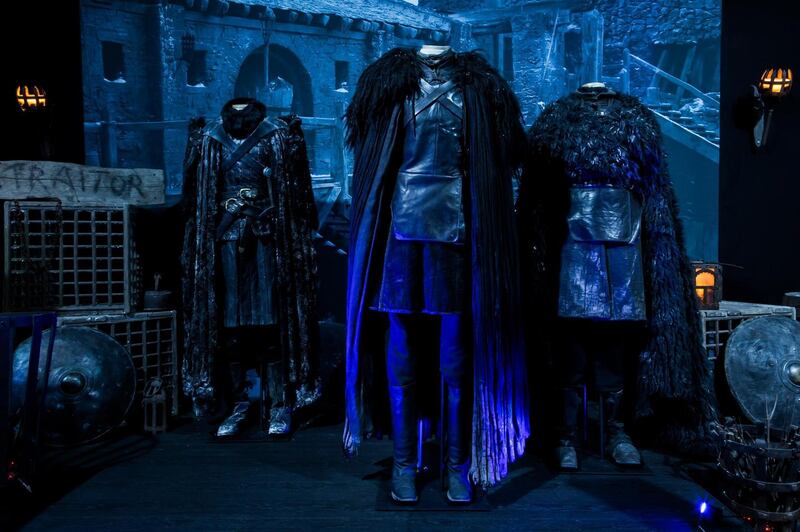
Even more jaw-dropping is the “winter soldier” coat Daenerys wore as she flew off on Drogon to rescue Jon Snow and his merry men in season seven. The outfit caused a sensation when it debuted, in August 2017. Vanity Fair dubbed it “stunning”. Vulture said it was “damn majestic”. Face to face it’s all the above, its swooping contours of fake rabbit fur marking the point high fantasy meets high fashion.
Turning a corner, we’re suddenly at Castle Black, where Jon Snow passed many years with the Night’s Watch. His black furs are there, alongside his Valyrian steel sword, Longclaw, and Samwell Tarly’s equally potent Heartsbane. There’s no touching, although a mounted replica of Longclaw is available for selfie opportunities. (You can also lie on the floor and pretend you are climbing a re-creation of the Wall.)
Conspicuously absent from Castle Black is the Ikea rug Tarly donned in the first series, back when the budget was about as bountiful as Stannis's sense of humour
Conspicuously absent from Castle Black is the Ikea rug Tarly donned in the first series, in 2011. Back then it was unclear whether Game of Thrones would be a hit, and the budget was about as bountiful as Stannis’s sense of humour. Against the clock, Michele Clapton sent an assistant to the Ikea around the corner to secure some black rugs – duly pressed into service in episode two.
Game of Thrones has travelled an incredible distance since then. And, walking the halls of the exhibition, there is a genuine feeling you are cheek by jowl with a juggernaut of popular culture. Season eight begins on Sunday night – at 2am on Monday, strictly speaking. Until then this incredible exhibition whets the appetite. I leave Belfast with a tingle down my spine and a realisation that finally, truly, at long last, winter is coming.
Game of Thrones: The Touring Exhibition runs from April 11th until September 1st. Tickets cost £15 for an adult and £10 for a child



















